59 Fruits That Start With M With Facts & Pictures

Munching on fruits is fun, but munching on fruits that begin with the letter M is even more mouthwatering every time.
From mangoes to melons, many fruits start with “M” & most are sweet, juicy, colorful, and packed with vitamins that help you feel strong.
This list will show you some of the most unique “M” fruits that grow on trees, bushes, and vines all around the world.
You’ll meet fruits that are soft, sour, big, small, red, green, and even ones that start with “M” but sound pretty funny too!
Let’s explore the fruity world of the letter M, one yummy bite at a time.
Maybe you’ll find a new favorite fruit today!
Top Fruits That Begin With The Letter M
Here are some famous fruits that begin with the letter “m”, for a yu-MM-y feel:
1. Maqui

Maqui is a small, dark purple berry that grows on the evergreen maqui shrub. It has a sweet, slightly tart flavor and is often used in juices, smoothies, and dietary supplements.
- Place of Origin: Southern Chile and Argentina
- Scientific Name: Aristotelia chilensis
- Famous Alternative Names: Chilean Wineberry, Chilean Blackberry
Nutritional Content per 100 grams:
| Nutrient | Amount |
|---|---|
| Calories | 43 |
| Fat | 0.2 g |
| Carbohydrates | 9.6 g |
| Protein | 0.6 g |
| Fiber | 5.2 g |
Health Benefits:
- High in antioxidants, particularly anthocyanins, which may help reduce inflammation
- Supports cardiovascular health
- It helps regulate blood sugar levels
2. Murray’s Plum

Murray’s Plum is a small, dark red to purple fruit with a tart flavor. It grows on the Murray’s Plum tree, which is native to certain regions of North America.
- Place of Origin: North America
- Scientific Name: Prunus murrayana
- Famous Alternative Names: Wild Goose Plum
Nutritional Content per 100 grams:
| Nutrient | Amount |
|---|---|
| Calories | 46 |
| Fat | 0.3 g |
| Carbohydrates | 11.4 g |
| Protein | 0.5 g |
| Fiber | 1.4 g |
Health Benefits:
- Contains vitamin A for immune function
- Offers vitamin C to support skin health
- Provides fiber to aid digestion
- Supplies natural phytonutrients with antioxidant properties
3. Mamey Sapote

Mamey Sapote is a large, oval fruit with rough, brown skin and vibrant orange flesh. It has a sweet, creamy flavor reminiscent of pumpkin, apricot, and almond.
- Place of Origin: Central America
- Scientific Name: Pouteria sapota
- Famous Alternative Names: Sapote, Mamey Apple
Nutritional Content per 100 grams:
| Nutrient | Amount |
|---|---|
| Calories | 124 |
| Fat | 0.4 g |
| Carbohydrates | 32.1 g |
| Protein | 1.5 g |
| Fiber | 5.4 g |
Health Benefits:
- High in dietary fiber, which aids digestion and promotes satiety
- Rich in vitamins A and C, supporting vision and immune health
- It contains antioxidants that may help reduce inflammation
4. Mexican Pitahaya

Mexican Pitahaya, also known as dragon fruit, is a vibrant fruit with bright pink or yellow skin and white or red flesh speckled with tiny black seeds. It has a mildly sweet taste.
- Place of Origin: Mexico
- Scientific Name: Hylocereus undatus
- Famous Alternative Names: Dragon Fruit, Strawberry Pear
Nutritional Content per 100 grams:
| Nutrient | Amount |
|---|---|
| Calories | 50 |
| Fat | 0.1 g |
| Carbohydrates | 11 g |
| Protein | 1.2 g |
| Fiber | 3 g |
Health Benefits:
- High in antioxidants, which protect against free radicals
- It is a good source of fiber, aiding in digestion and promoting gut health
- Supports immune health due to its vitamin C content
5. Mango

Mango is a juicy, tropical fruit with smooth, golden-yellow flesh and a large, flat seed. It has a sweet and slightly tangy flavor.
- Place of Origin: South Asia
- Scientific Name: Mangifera indica
- Famous Alternative Names: King of Fruits, Amra, Aam
Nutritional Content per 100 grams:
| Nutrient | Amount |
|---|---|
| Calories | 60 |
| Fat | 0.4 g |
| Carbohydrates | 15 g |
| Protein | 0.8 g |
| Fiber | 1.6 g |
Health Benefits:
- High in vitamin C, which boosts the immune system
- It contains enzymes that aid in digestion
- Rich in antioxidants that support overall health
6. Maypop

Maypop is a passion fruit variety with a tough outer rind and juicy, seedy interior. It has a tart and sweet flavor.
- Place of Origin: Southeastern United States
- Scientific Name: Passiflora incarnata
- Famous Alternative Names: Purple Passionflower, Wild Apricot
Nutritional Content per 100 grams:
| Nutrient | Amount |
|---|---|
| Calories | 70 |
| Fat | 0.4 g |
| Carbohydrates | 23.4 g |
| Protein | 2.2 g |
| Fiber | 10.4 g |
Health Benefits:
- Rich in fiber, promoting healthy digestion
- It contains vitamins A and C, which support skin and immune health
- It has calming effects due to its flavonoid content
7. Mimusops Elengi

Mimusops Elengi is a tropical fruit with a sweet, aromatic flavor. It is often used in traditional medicine and as a flavoring agent.
- Place of Origin: South Asia
- Scientific Name: Mimusops elengi
- Famous Alternative Names: Spanish Cherry, Bullet Wood
Nutritional Content per 100 grams:
| Nutrient | Amount |
|---|---|
| Calories | 96 |
| Fat | 0.3 g |
| Carbohydrates | 22.5 g |
| Protein | 0.8 g |
| Fiber | 5.2 g |
Health Benefits:
- High in antioxidants, which may protect against oxidative stress
- Supports oral health due to its astringent properties
- It helps regulate blood sugar levels
8. Malus sieversii
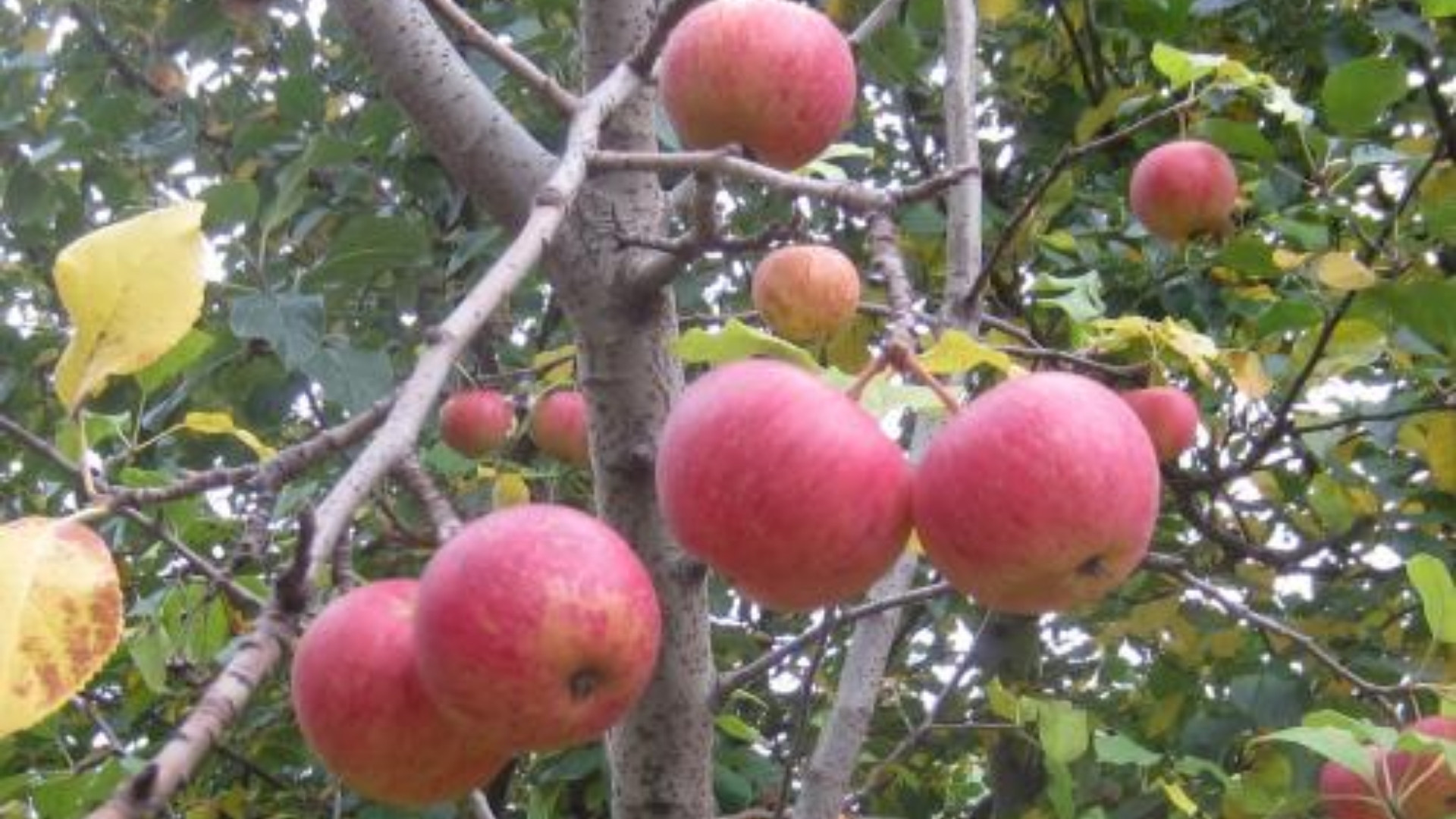
Malus sieversii is a wild apple species with a crisp texture and a tart flavor. It is considered the ancestor of the modern cultivated apple.
- Place of Origin: Central Asia
- Scientific Name: Malus sieversii
- Famous Alternative Names: Wild Apple, Kazakh Apple
Nutritional Content per 100 grams:
| Nutrient | Amount |
|---|---|
| Calories | 52 |
| Fat | 0.2 g |
| Carbohydrates | 14 g |
| Protein | 0.3 g |
| Fiber | 2.4 g |
Health Benefits:
- Rich in dietary fiber, supporting digestive health
- Contains vitamin C, which boosts the immune system
- Provides polyphenols that have antioxidant properties
9 Midgen Berry

Midgen Berry is a small, white to pale pink fruit with a sweet flavor. It grows on a shrub native to Australia and is often used in jams and desserts.
- Place of Origin: Australia
- Scientific Name: Austromyrtus dulcis
- Famous Alternative Names: Midyim, Sandberry
Nutritional Content per 100 grams:
| Nutrient | Amount |
|---|---|
| Calories | 45 |
| Fat | 0.1 g |
| Carbohydrates | 10 g |
| Protein | 0.7 g |
| Fiber | 2.6 g |
Health Benefits:
- High in antioxidants, which protect against free radical damage
- Supports immune health due to its vitamin C content
- It contains fiber that aids in digestion
10. Manchurian Crab Apple

Manchurian Crab Apple is a small, tart fruit that grows on a deciduous tree. It is often used in preserves and as a decorative plant.
- Place of Origin: Northeast Asia
- Scientific Name: Malus baccata
- Famous Alternative Names: Siberian Crab Apple, Chinese Apple
Nutritional Content per 100 grams:
| Nutrient | Amount |
|---|---|
| Calories | 52 |
| Fat | 0.2 g |
| Carbohydrates | 14 g |
| Protein | 0.3 g |
| Fiber | 2.4 g |
Health Benefits:
- Rich in dietary fiber, promoting healthy digestion
- It contains vitamin C, supporting immune function
- Provides antioxidants that may help reduce inflammation
11. Manchurian Cherry

Manchurian Cherry is a small, red fruit with a sweet and slightly tart flavor. It grows on a tree native to East Asia.
- Place of Origin: East Asia
- Scientific Name: Prunus maackii
- Famous Alternative Names: Amur Cherry, Maack’s Cherry
Nutritional Content per 100 grams:
| Nutrient | Amount |
|---|---|
| Calories | 63 |
| Fat | 0.2 g |
| Carbohydrates | 16 g |
| Protein | 1 g |
| Fiber | 2 g |
Health Benefits:
- Rich in antioxidants, which may protect against oxidative stress
- Good source of vitamins A and C, supporting skin and immune health
- It contains fiber that aids in digestion
12. Mangosteen

Mangosteen is a tropical fruit with a thick, purple rind and juicy, white flesh. It has a sweet and tangy flavor.
- Place of Origin: Southeast Asia
- Scientific Name: Garcinia mangostana
- Famous Alternative Names: Queen of Fruits, Mangostan
Nutritional Content per 100 grams:
| Nutrient | Amount |
|---|---|
| Calories | 73 |
| Fat | 0.6 g |
| Carbohydrates | 18 g |
| Protein | 0.4 g |
| Fiber | 1.8 g |
Health Benefits:
- High in antioxidants, particularly xanthones, which may reduce inflammation
- Supports immune health due to its vitamin C content
- It has anti-inflammatory and antimicrobial properties
13. Mirabelle Plum

Mirabelle Plum is a small, yellow fruit with a sweet and slightly tangy flavor. It is often used in jams, desserts, and brandy production.
- Place of Origin: France
- Scientific Name: Prunus domestica subsp. syriaca
- Famous Alternative Names: Mirabelle, Yellow Plum
Nutritional Content per 100 grams:
| Nutrient | Amount |
|---|---|
| Calories | 46 |
| Fat | 0.3 g |
| Carbohydrates | 11.4 g |
| Protein | 0.7 g |
| Fiber | 1.5 g |
Health Benefits:
- Rich in dietary fiber, promoting healthy digestion
- It contains vitamins A and C, supporting skin and immune health
- Provides antioxidants that may protect against oxidative stress
14. Mulberry
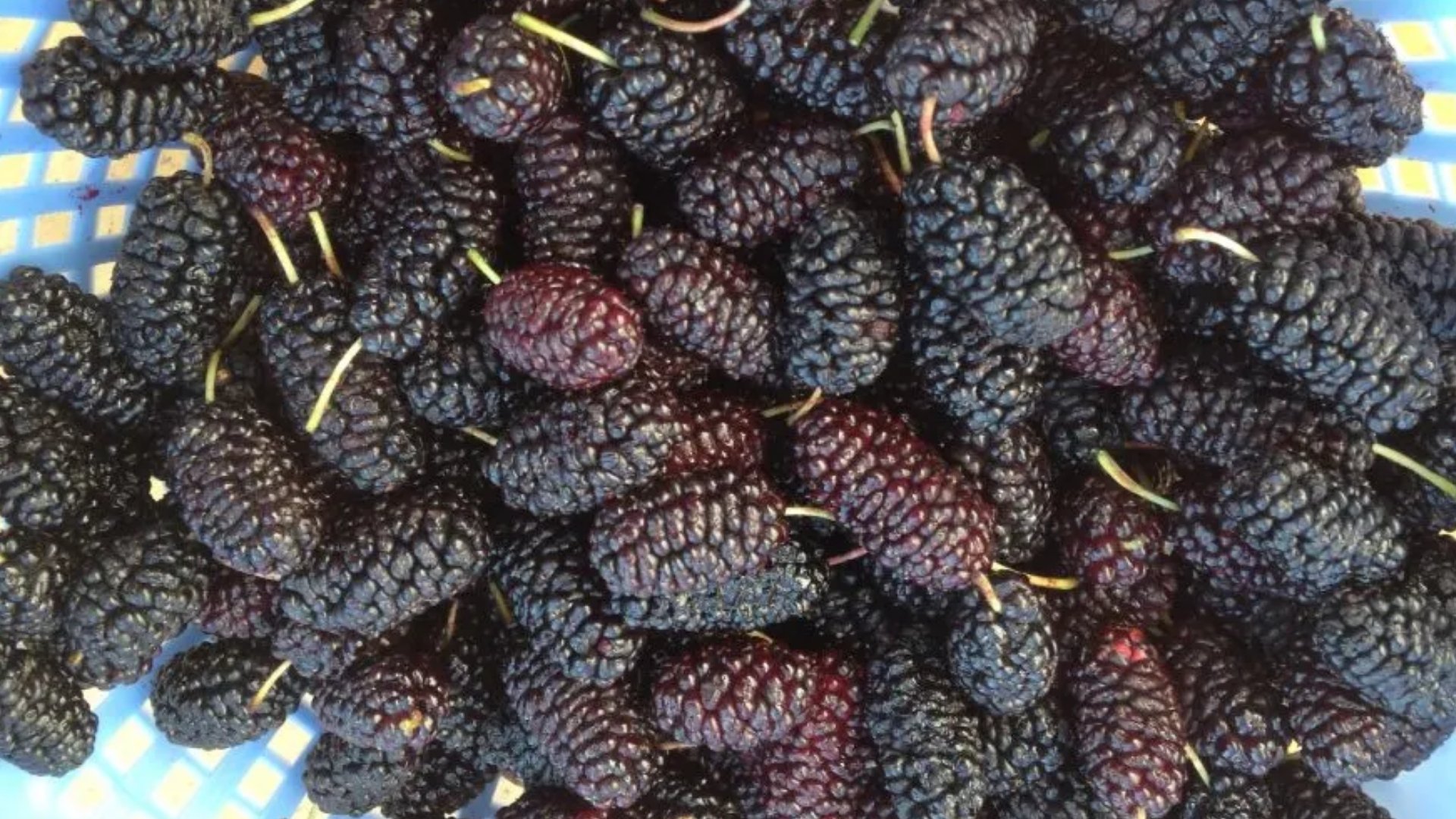
Mulberry is a small, sweet fruit that grows on mulberry trees. It comes in various colors, including red, black, and white.
- Place of Origin: China
- Scientific Name: Morus
- Famous Alternative Names: Morus Berry, Shahtoot
Nutritional Content per 100 grams:
| Nutrient | Amount |
|---|---|
| Calories | 43 |
| Fat | 0.4 g |
| Carbohydrates | 9.8 g |
| Protein | 1.4 g |
| Fiber | 1.7 g |
Health Benefits:
- High in vitamin C, which boosts the immune system
- It contains iron, which supports blood health
- Provides antioxidants that may reduce inflammation
15. Malay Rose Apple

The Malay Rose Apple is a tropical fruit with waxy, red skin and crisp, juicy flesh. It has a sweet, rose-like flavor.
- Place of Origin: Southeast Asia
- Scientific Name: Syzygium malaccense
- Famous Alternative Names: Malay Apple, Mountain Apple
Nutritional Content per 100 grams:
| Nutrient | Amount |
|---|---|
| Calories | 25 |
| Fat | 0.2 g |
| Carbohydrates | 5.7 g |
| Protein | 0.3 g |
| Fiber | 1.5 g |
Health Benefits:
- High in vitamin C, supporting immune health
- It contains fiber that aids in digestion
- Provides antioxidants that may help reduce inflammation
16. Moriche Palm Fruit

Moriche Palm Fruit is a tropical fruit with a reddish-brown, scaly skin and sweet, creamy flesh. It is often used in traditional medicine and as a food source.
- Place of Origin: South America
- Scientific Name: Mauritia flexuosa
- Famous Alternative Names: Buriti, Aguaje
Nutritional Content per 100 grams:
| Nutrient | Amount |
|---|---|
| Calories | 62 |
| Fat | 1.5 g |
| Carbohydrates | 13 g |
| Protein | 1.5 g |
| Fiber | 4 g |
Health Benefits:
- High in vitamin A, supporting vision and skin health
- Rich in antioxidants that may protect against free radical damage
- It contains healthy fats that support heart health
17. Miracle Fruit

Miracle Fruit is a small, red berry known for its unique ability to alter taste perception, making sour foods taste sweet.
- Place of Origin: West Africa
- Scientific Name: Synsepalum dulcificum
- Famous Alternative Names: Miracle Berry, Sweet Berry
Nutritional Content per 100 grams:
| Nutrient | Amount |
|---|---|
| Calories | 20 |
| Fat | 0.1 g |
| Carbohydrates | 5 g |
| Protein | 0.2 g |
| Fiber | 2 g |
Health Benefits:
- It may help with weight loss by reducing sugar intake
- Potential aid for chemotherapy patients by improving taste perception
- It contains antioxidants that can support overall health
18. Myers Plum

Myers Plum is a variety of plums known for its juicy flesh and sweet-tart flavor, often enjoyed fresh or in desserts.
- Place of Origin: United States
- Scientific Name: Prunus domestica
- Famous Alternative Names: Myrobalan Plum
Nutritional Content per 100 grams:
| Nutrient | Amount |
|---|---|
| Calories | 46 |
| Fat | 0.3 g |
| Carbohydrates | 11.4 g |
| Protein | 0.7 g |
| Fiber | 1.4 g |
Health Benefits:
- Rich in vitamins C and K, supporting immune and bone health
- High in fiber, promoting digestive health
- It contains antioxidants that may reduce inflammation
19. Malabar Plum

Malabar Plum is a tropical fruit with a crisp texture and a slightly sweet, mildly acidic flavor, often enjoyed fresh or in jams.
- Place of Origin: India and Southeast Asia
- Scientific Name: Syzygium jambos
- Famous Alternative Names: Rose Apple, Jambu
Nutritional Content per 100 grams:
| Nutrient | Amount |
|---|---|
| Calories | 30 |
| Fat | 0.1 g |
| Carbohydrates | 7 g |
| Protein | 0.6 g |
| Fiber | 1 g |
Health Benefits:
- Rich in vitamins A and C, boosting immunity and eye health
- It contains dietary fiber, aiding digestion
- It may have anti-inflammatory properties
20. Mouse Melon
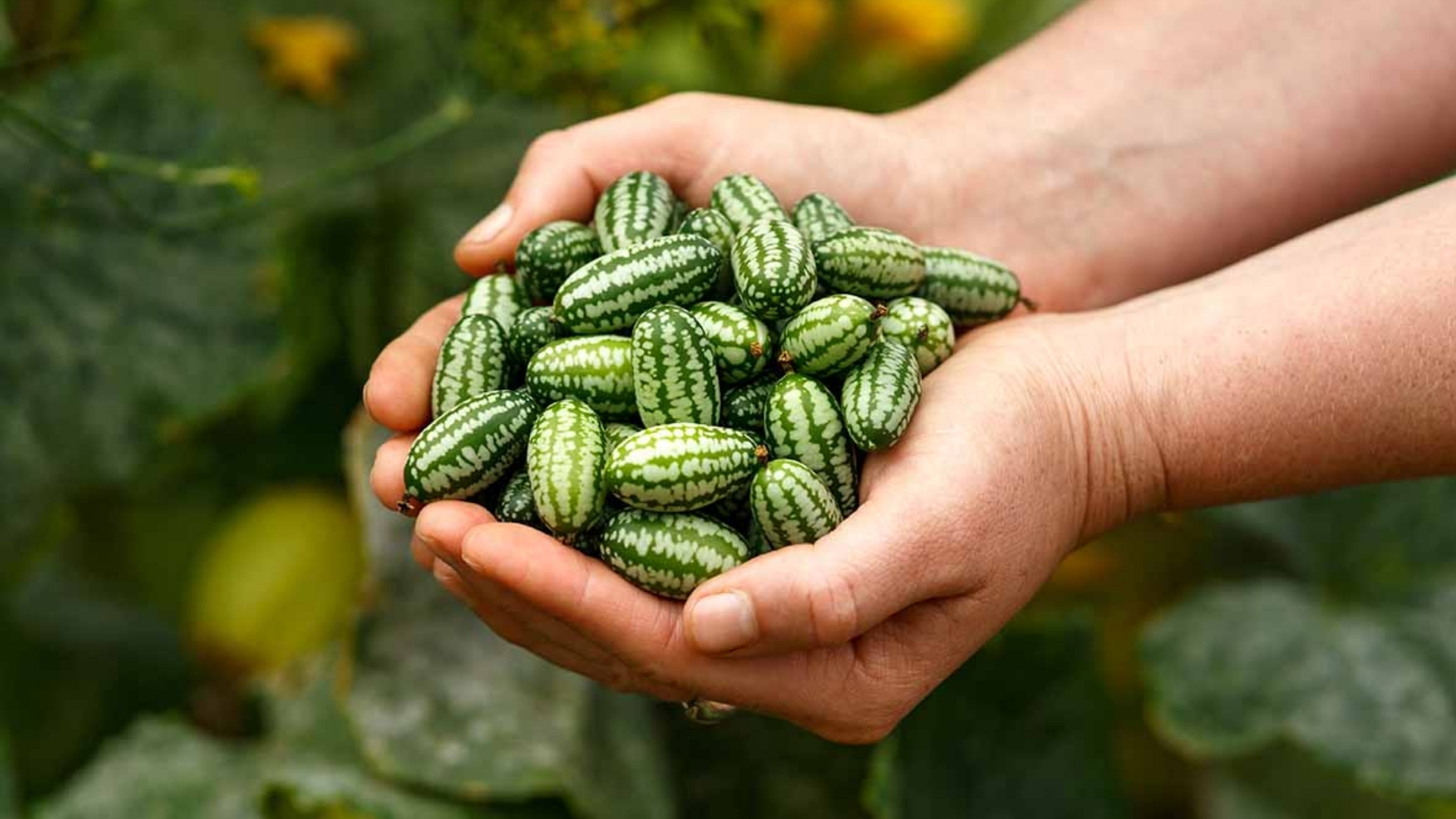
Mouse Melon, also known as Mexican Sour Gherkin, is a tiny fruit that looks like a miniature watermelon but tastes like a cucumber with a hint of sourness.
- Place of Origin: Mexico and Central America
- Scientific Name: Melothria scabra
- Famous Alternative Names: Cucamelon, Mexican Sour Gherkin
Nutritional Content per 100 grams:
| Nutrient | Amount |
|---|---|
| Calories | 14 |
| Fat | 0.1 g |
| Carbohydrates | 3.4 g |
| Protein | 0.6 g |
| Fiber | 1.6 g |
Health Benefits:
- Low in calories, suitable for weight management
- High in fiber, promoting digestive health
- It contains vitamins C and E, supporting immune function
21. Mountain Serviceberry

Mountain Serviceberry is a small, dark purple fruit with a sweet, almond-like flavor, often used in pies, jams, and jellies.
- Place of Origin: North America
- Scientific Name: Amelanchier alnifolia
- Famous Alternative Names: Saskatoon Berry, Juneberry
Nutritional Content per 100 grams:
| Nutrient | Amount |
|---|---|
| Calories | 50 |
| Fat | 0.5 g |
| Carbohydrates | 12 g |
| Protein | 1 g |
| Fiber | 2.4 g |
Health Benefits:
- Rich in antioxidants, which may protect against cellular damage
- High in fiber, aiding in digestive health
- It contains essential vitamins and minerals, supporting overall well-being
22. Mombin

Mombin is a small, oval fruit with a tangy flavor, often used in beverages, jams, and traditional medicine.
- Place of Origin: Tropical Americas
- Scientific Name: Spondias mombin
- Famous Alternative Names: Hog Plum, Yellow Mombin
Nutritional Content per 100 grams:
| Nutrient | Amount |
|---|---|
| Calories | 60 |
| Fat | 0.3 g |
| Carbohydrates | 15 g |
| Protein | 0.5 g |
| Fiber | 2 g |
Health Benefits:
- Rich in vitamin C, boosting the immune system
- It contains dietary fiber, promoting digestive health
- It has anti-inflammatory properties
23. Mayhaw

Mayhaw is a small, tart fruit often used in jellies, syrups, and sauces, popular in Southern United States cuisine.
- Place of Origin: Southeastern United States
- Scientific Name: Crataegus aestivalis
- Famous Alternative Names: Hawthorn Berry
Nutritional Content per 100 grams:
| Nutrient | Amount |
|---|---|
| Calories | 58 |
| Fat | 0.4 g |
| Carbohydrates | 14.3 g |
| Protein | 0.8 g |
| Fiber | 3.6 g |
Health Benefits:
- High in antioxidants, supporting heart health
- Rich in vitamin C, enhancing immune function
- It contains dietary fiber, aiding in digestion
24. Marionberry

Marionberry is a blackberry known for its sweet-tart flavor and is commonly used in desserts, jams, and juices.
- Place of Origin: United States (Oregon)
- Scientific Name: Rubus L. subgenus Rubus
- Famous Alternative Names: Marion Blackberry
Nutritional Content per 100 grams:
| Nutrient | Amount |
|---|---|
| Calories | 52 |
| Fat | 0.5 g |
| Carbohydrates | 12 g |
| Protein | 1 g |
| Fiber | 5.3 g |
Health Benefits:
- Rich in antioxidants, supporting cellular health
- High in fiber, promoting digestive health
- It contains vitamins C and K, supporting immune and bone health
25. Momordica Fruit

Momordica Fruit, also known as bitter melon, is a tropical fruit known for its distinctive bitter taste and is often used in Asian cuisine and traditional medicine.
- Place of Origin: Tropical Asia
- Scientific Name: Momordica charantia
- Famous Alternative Names: Bitter Melon, Bitter Gourd
Nutritional Content per 100 grams:
| Nutrient | Amount |
|---|---|
| Calories | 17 |
| Fat | 0.2 g |
| Carbohydrates | 3.7 g |
| Protein | 1 g |
| Fiber | 2.8 g |
Health Benefits:
- It helps in regulating blood sugar levels
- It contains antioxidants that support overall health
- Rich in vitamins A and C, promoting skin and immune health
26. Muskmelon

Muskmelon is a sweet, fragrant fruit with a netted rind and orange or green flesh, often enjoyed fresh or in fruit salads.
- Place of Origin: Persia
- Scientific Name: Cucumis melo
- Famous Alternative Names: Cantaloupe, Rockmelon
Nutritional Content per 100 grams:
| Nutrient | Amount |
|---|---|
| Calories | 34 |
| Fat | 0.2 g |
| Carbohydrates | 8.2 g |
| Protein | 0.8 g |
| Fiber | 0.9 g |
Health Benefits:
- High in vitamins A and C, supporting vision and immune health
- Hydrating due to its high water content
- It contains antioxidants that may protect against cellular damage
27. Minneola Tangelo

Minneola Tangelo is a hybrid citrus fruit with a bright orange rind and juicy, sweet-tart flesh, often enjoyed fresh or juiced.
- Place of Origin: United States
- Scientific Name: Citrus × tangelo
- Famous Alternative Names: Honeybell
Nutritional Content per 100 grams:
| Nutrient | Amount |
|---|---|
| Calories | 47 |
| Fat | 0.2 g |
| Carbohydrates | 11.5 g |
| Protein | 0.8 g |
| Fiber | 2 g |
Health Benefits:
- Rich in vitamin C, boosting the immune system
- It contains dietary fiber, promoting digestive health
- It supports skin health due to its antioxidant content
28. Marula

Marula is a small, yellow fruit with a tart flavor, often used to make beverages, jams, and cosmetics.
- Place of Origin: Southern Africa
- Scientific Name: Sclerocarya birrea
- Famous Alternative Names: Elephant Tree Fruit
Nutritional Content per 100 grams:
| Nutrient | Amount |
|---|---|
| Calories | 61 |
| Fat | 0.6 g |
| Carbohydrates | 15 g |
| Protein | 0.7 g |
| Fiber | 2 g |
Health Benefits:
- Rich in vitamin C, supporting immune function
- It contains antioxidants that may protect against cellular damage
- High in dietary fiber, promoting digestive health
29. Manilkara Elata
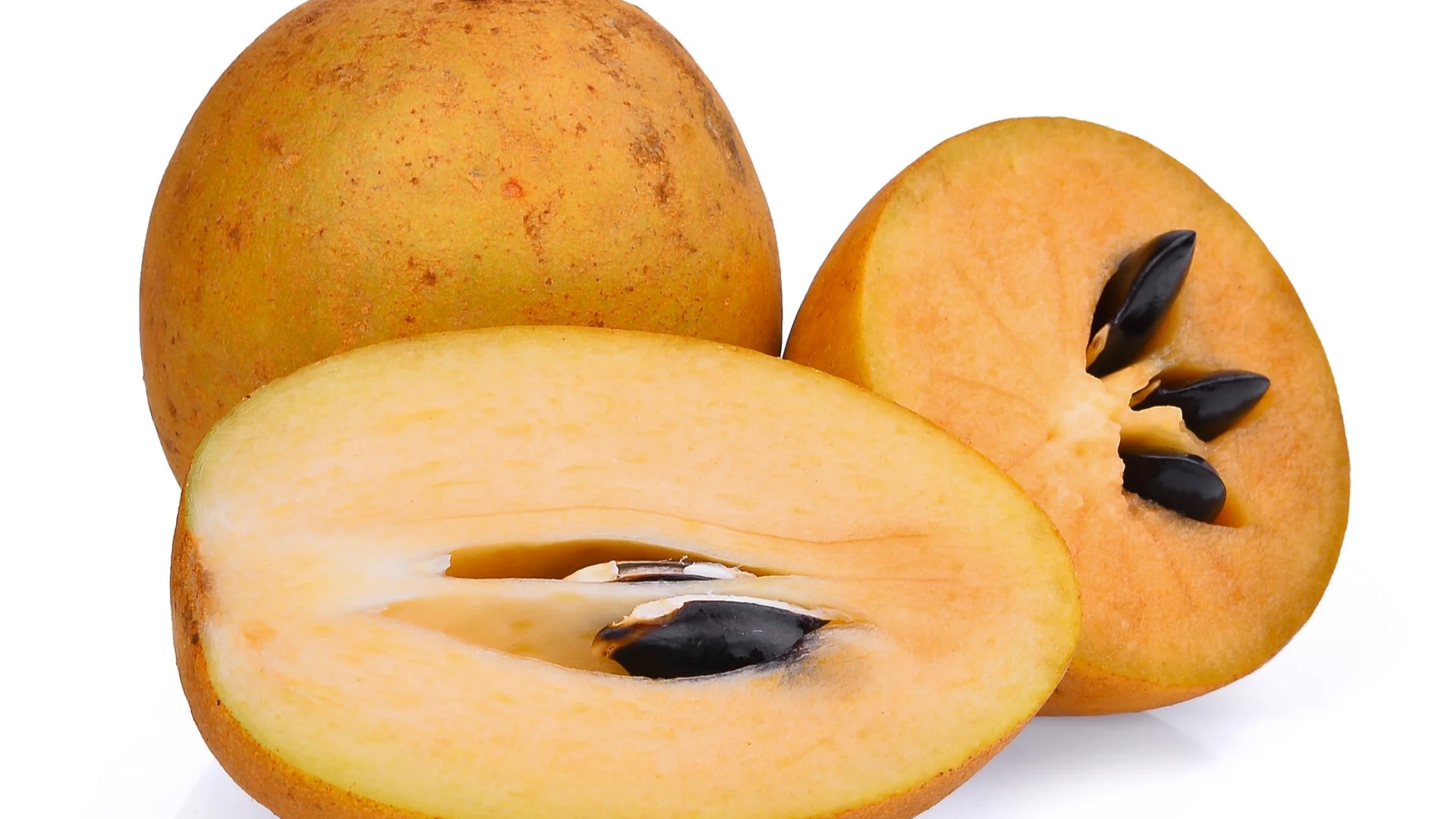
Manilkara Elata is a tropical fruit known for its sweet, aromatic flavor and is often consumed fresh or used in desserts.
- Place of Origin: Central and South America
- Scientific Name: Manilkara elata
- Famous Alternative Names: Sapodilla
Nutritional Content per 100 grams:
| Nutrient | Amount |
|---|---|
| Calories | 83 |
| Fat | 1.1 g |
| Carbohydrates | 20 g |
| Protein | 0.4 g |
| Fiber | 5.3 g |
Health Benefits:
- High in dietary fiber, promoting digestive health
- Rich in antioxidants, supporting overall health
- It contains essential vitamins and minerals, enhancing general well-being
30. Mexican Plum
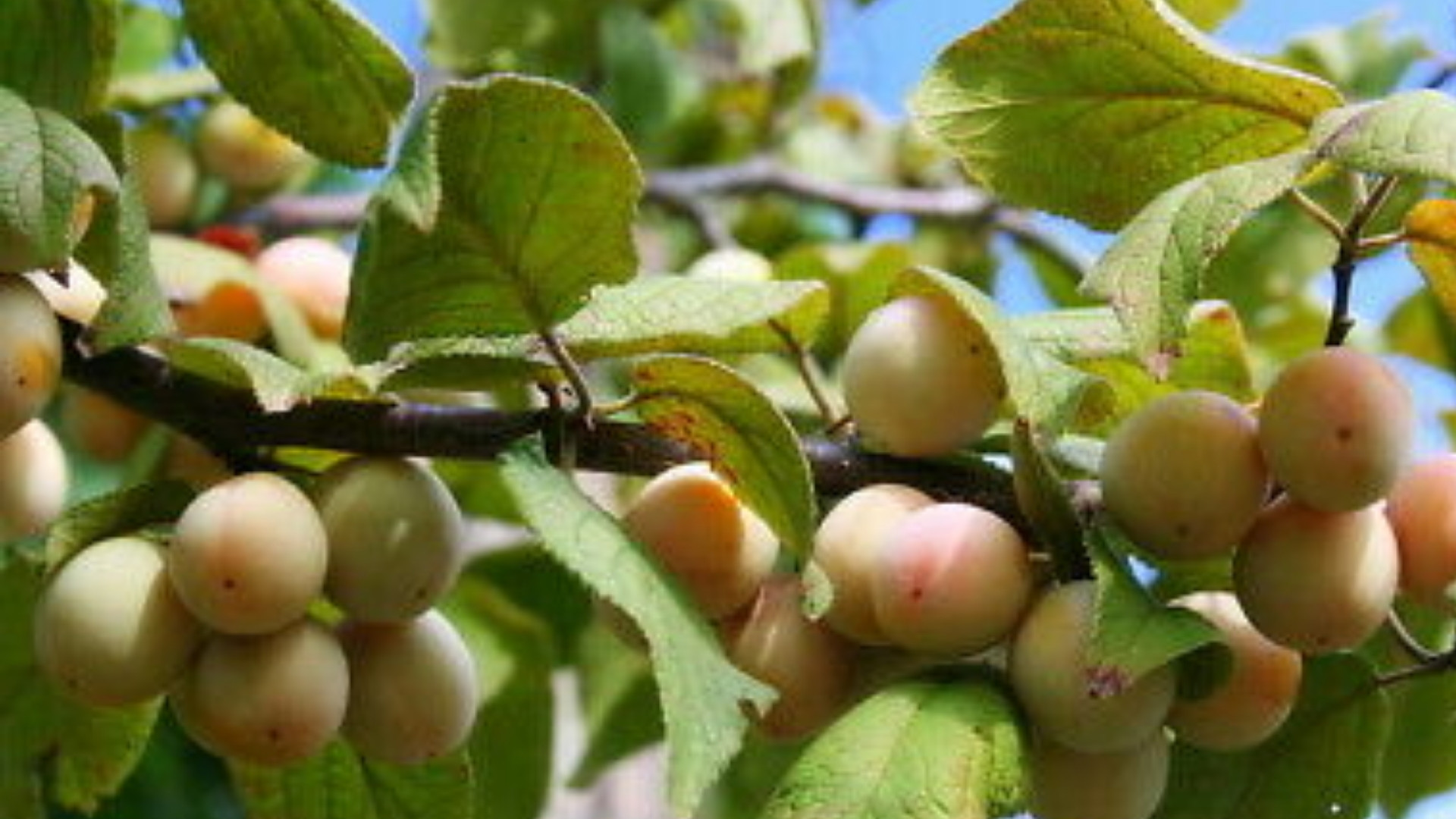
Mexican Plum is a small, tart fruit often used in preserves, sauces, and traditional dishes in Mexican cuisine.
- Place of Origin: Mexico
- Scientific Name: Prunus mexicana
- Famous Alternative Names: Texas Plum
Nutritional Content per 100 grams:
| Nutrient | Amount |
|---|---|
| Calories | 46 |
| Fat | 0.3 g |
| Carbohydrates | 11 g |
| Protein | 0.7 g |
| Fiber | 1.4 g |
Health Benefits:
- Rich in vitamins C and K, supporting immune and bone health
- High in fiber, promoting digestive health
- It contains antioxidants that may reduce inflammation
31. Mandarin Orange

Mandarin Orange is a small citrus fruit with a sweet, juicy flavor and is commonly eaten fresh or used in juices and salads.
- Place of Origin: China
- Scientific Name: Citrus reticulata
- Famous Alternative Names: Tangerine
Nutritional Content per 100 grams:
| Nutrient | Amount |
|---|---|
| Calories | 53 |
| Fat | 0.3 g |
| Carbohydrates | 13.3 g |
| Protein | 0.8 g |
| Fiber | 1.8 g |
Health Benefits:
- Rich in vitamin C, boosting the immune system
- It contains antioxidants, supporting overall health
- High in fiber, promoting digestive health
32. Mabolo
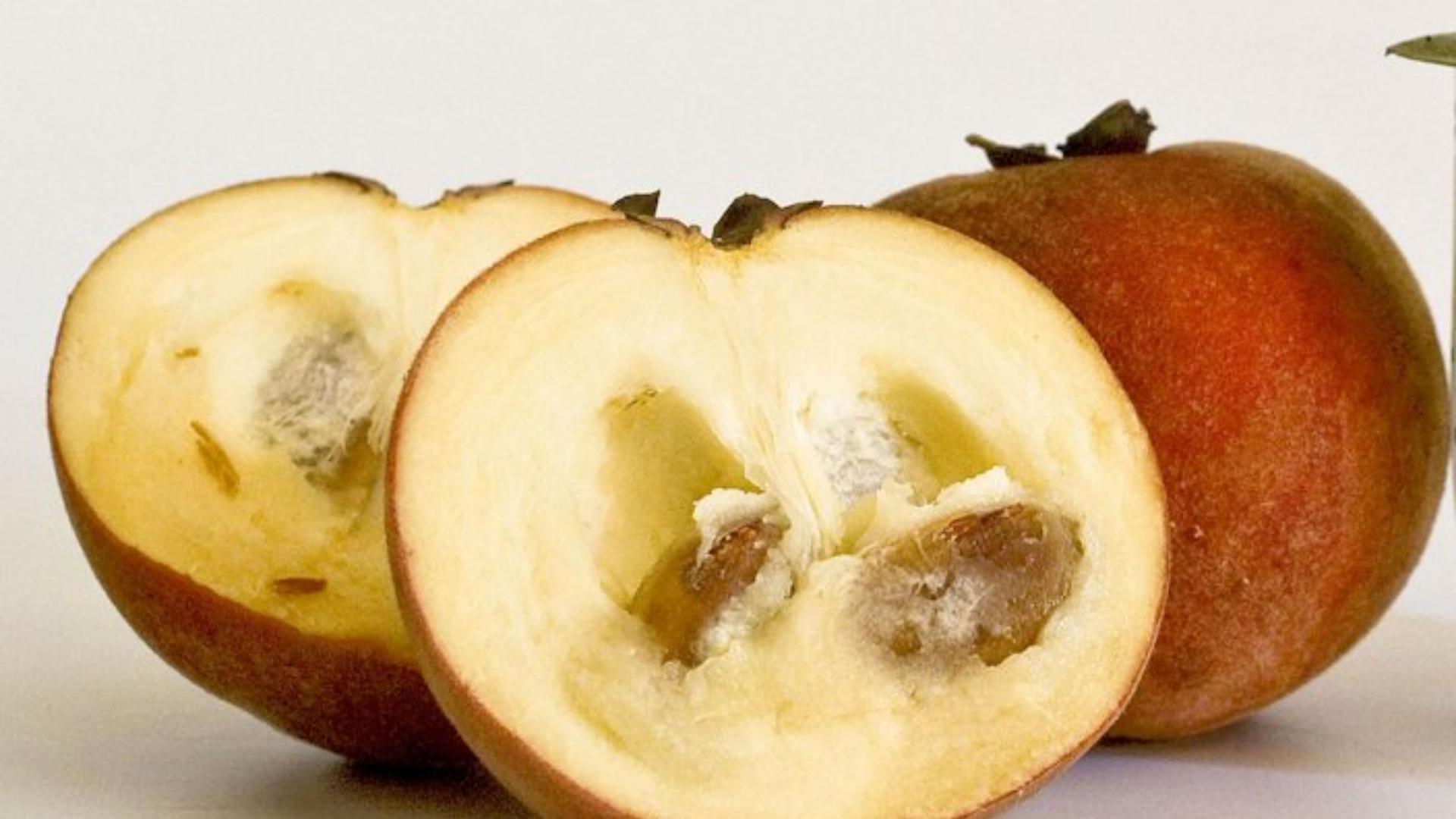
With its reddish-brown, velvety skin and creamy pink flesh, this unique fruit offers a mild, pleasing aroma and a slightly mealy texture.
Often eaten fresh, Mabolo is also popular in local desserts and salads.
The fruit’s size and color can vary depending on where it grows.
- Place of Origin: Philippines and Taiwan
- Scientific Name: Diospyros blancoi
- Famous Alternative Names: Velvet Apple, Butter Fruit, Kamagong
Nutritional Content per 100 grams:
| Nutrient | Amount |
|---|---|
| Calories | 45 |
| Fat | 0.6 g |
| Carbohydrates | 10.7 g |
| Protein | 0.6 g |
| Fiber | 3.2 g |
Health Benefits:
- High in dietary fiber, which supports healthy digestion
- Rich in vitamin C for immune system support
- Good source of antioxidants that help protect against oxidative stress
- Supplies essential minerals that benefit bone and metabolic health
33. Madrono
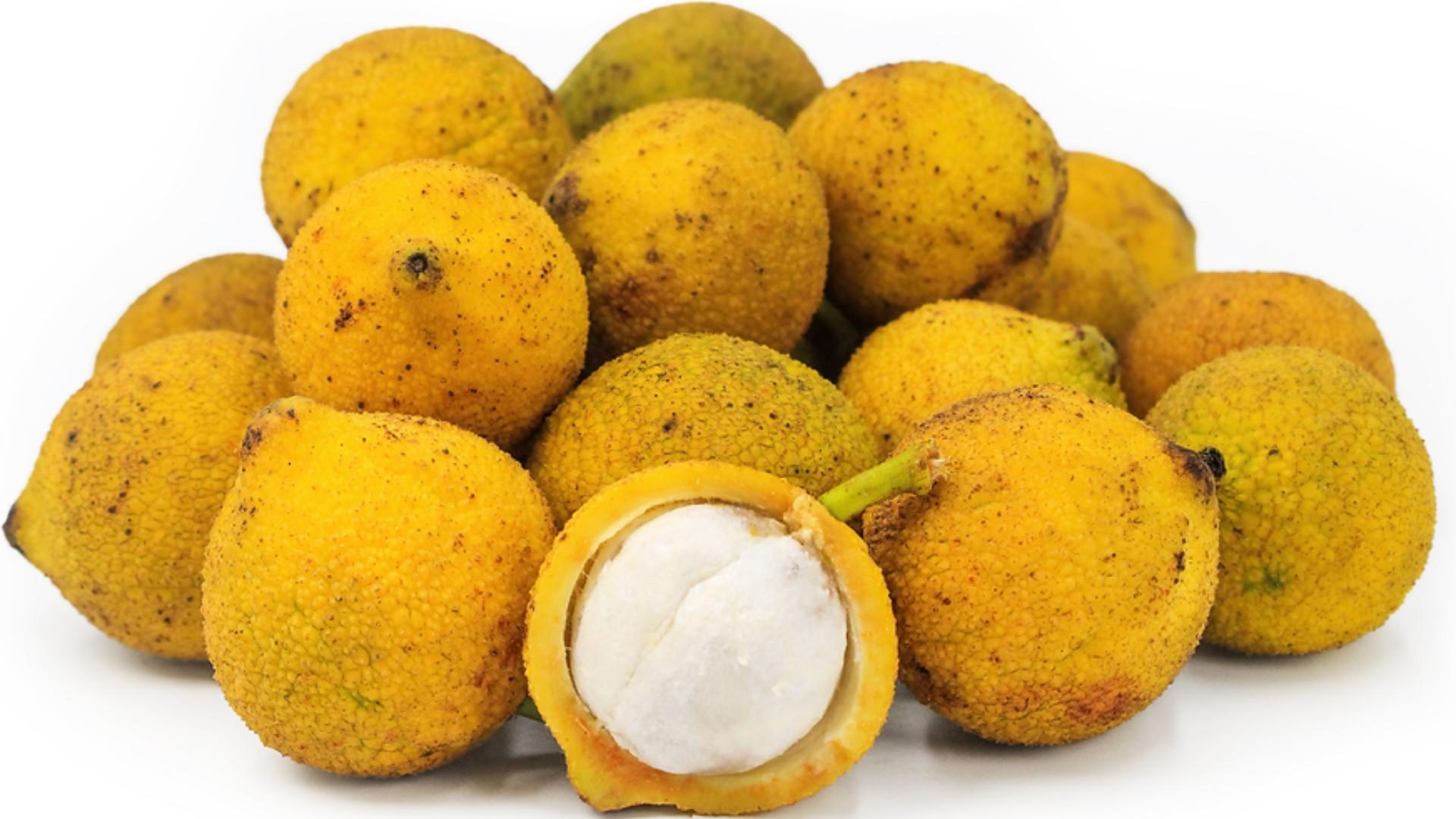
Distinctive for its bright red, thick, warty rind and creamy, sweet flesh, this fruit is relished raw or made into jams and beverages.
Madrono trees are visually striking and can produce fruit in abundance during the season.
- Place of Origin: Central and South America
- Scientific Name: Garcinia madruno
- Famous Alternative Names: Lemon Drop Mangosteen, Charichuelo
Nutritional Content per 100 grams:
| Nutrient | Amount |
|---|---|
| Calories | 45 |
| Fat | 0.6 g |
| Carbohydrates | 10.7 g |
| Protein | 0.6 g |
| Fiber | 3.2 g |
Health Benefits:
- Contains antioxidants that may help reduce inflammation
- Good source of vitamin C, which supports immunity
- Provides fiber for digestive wellness
- Traditionally used for its hydrating and refreshing qualities
34. Malpighia
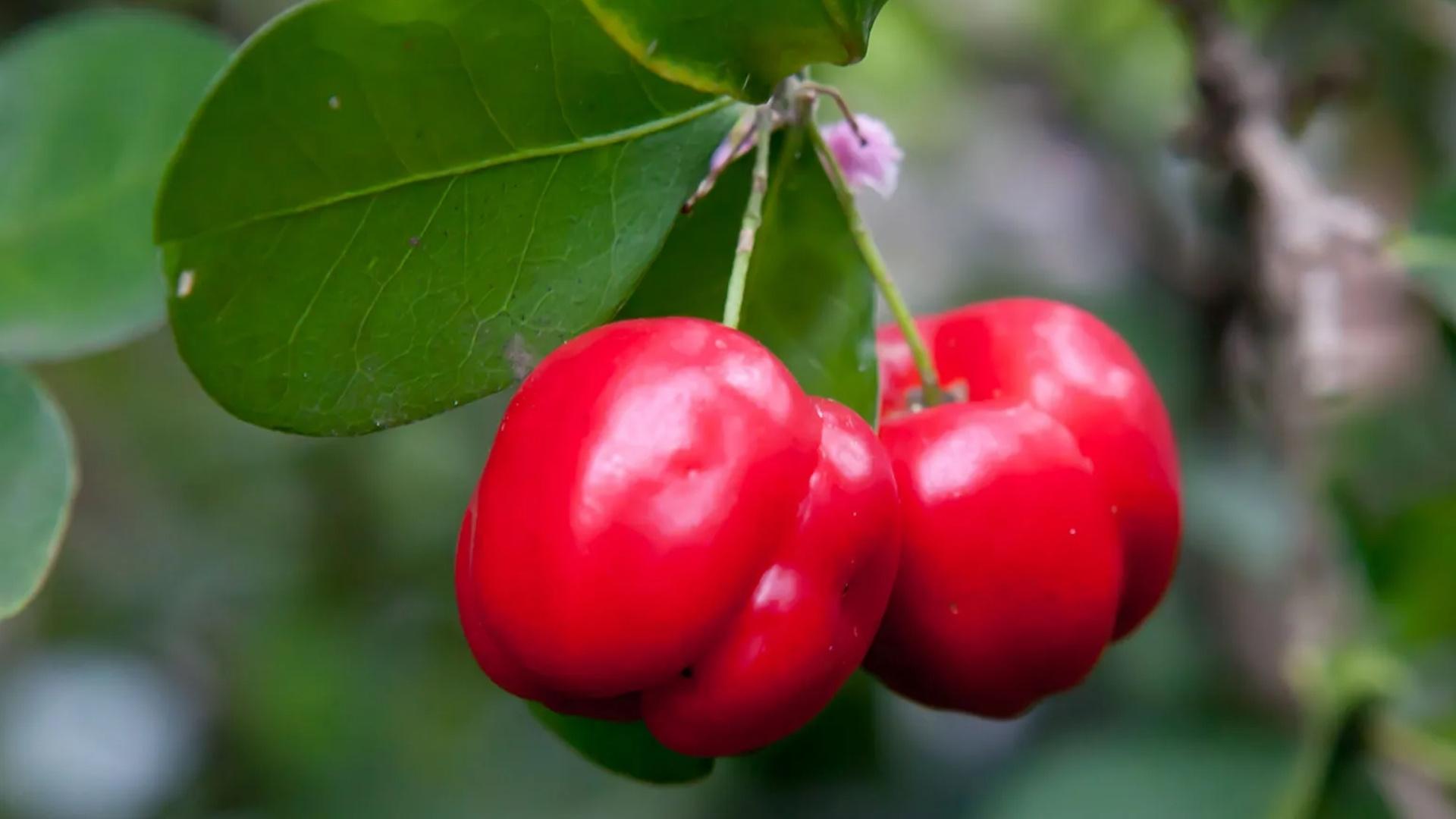
Small, bright red berries with a juicy, tart-sweet flavor, these are often used in juices, preserves, and dietary supplements.
The fruit is harvested from small shrubs and prized for its vibrant color and versatility.
- Place of Origin: Caribbean, Central and South America
- Scientific Name: Malpighia emarginata
- Famous Alternative Names: Acerola, Barbados Cherry, West Indian Cherry
Nutritional Content per 100 grams:
| Nutrient | Amount |
|---|---|
| Calories | 32 |
| Fat | 0.3 g |
| Carbohydrates | 7.7 g |
| Protein | 0.4 g |
| Fiber | 1.1 g |
Health Benefits:
- Exceptionally high in vitamin C, supporting immune health
- Rich in antioxidants that can protect against oxidative stress
- Promotes collagen production for skin health
- Provides fiber that aids in digestion
35. Malabar Nut Fruit
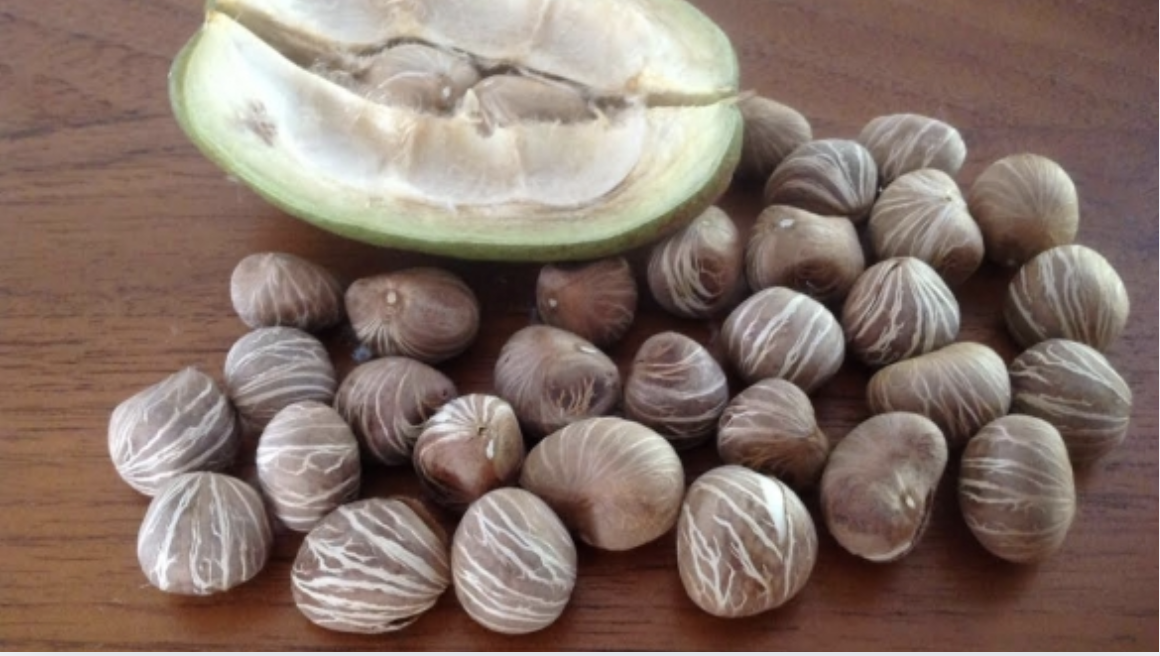
This distinctive fruit, usually green and slender, is produced by a small evergreen shrub and is traditionally used in Ayurvedic preparations.
It is more commonly valued for its medicinal properties than its taste.
- Place of Origin: Indian subcontinent and Southeast Asia
- Scientific Name: Justicia adhatoda
- Famous Alternative Names: Adhatoda, Vasaka
Nutritional Content per 100 grams:
| Nutrient | Amount |
|---|---|
| Calories | 42 |
| Fat | 0.7 g |
| Carbohydrates | 8.5 g |
| Protein | 1.2 g |
| Fiber | 2.3 g |
Health Benefits:
- Contains compounds that support respiratory health
- May exhibit anti-inflammatory properties
- Traditionally used to soothe coughs and colds
- Provides antioxidants beneficial to overall wellness
36. Mammee Apple
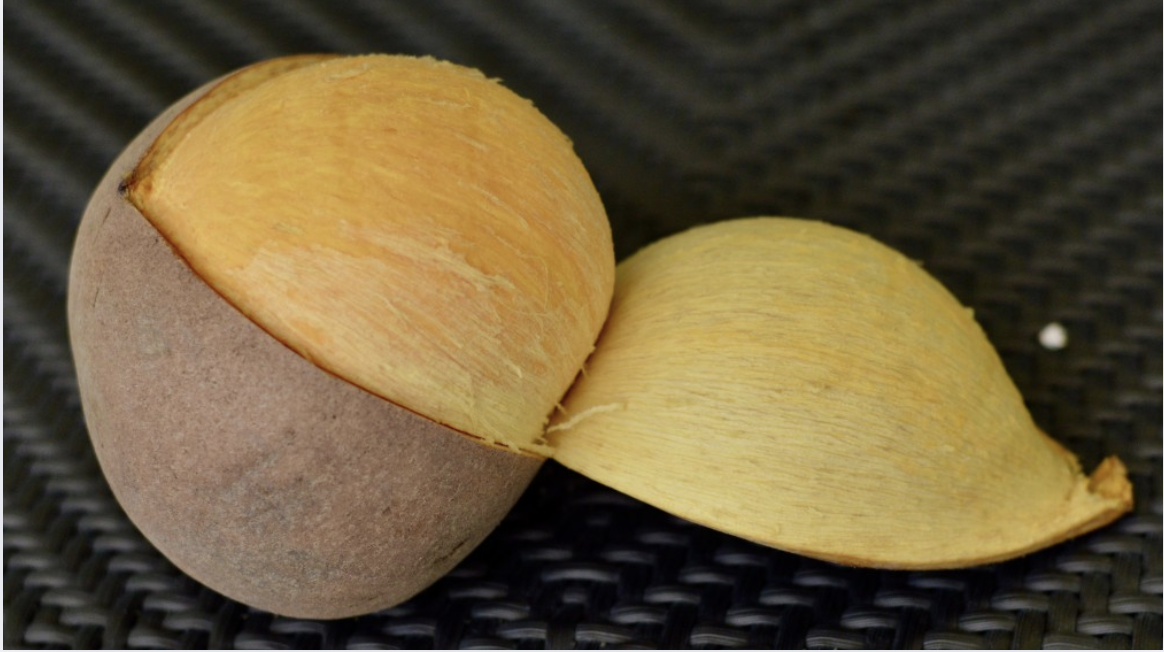
Large, round fruit with rough brown skin and fragrant, sweet yellow to orange pulp, it can be eaten fresh, juiced, or preserved.
The taste is a balance between sweet and tangy, making it popular for desserts and drinks.
- Place of Origin: Caribbean and northern South America
- Scientific Name: Mammea americana
- Famous Alternative Names: Mammee, Tropical Apricot, South American Apricot
Nutritional Content per 100 grams:
| Nutrient | Amount |
|---|---|
| Calories | 65 |
| Fat | 0.6 g |
| Carbohydrates | 16 g |
| Protein | 1 g |
| Fiber | 4.3 g |
Health Benefits:
- Rich in vitamins A and C, beneficial for vision and immunity
- High fiber supports digestive health
- Contains antioxidants that help protect cells
- Can provide minerals important for metabolic function
37. Mamoncillo

These small, green, grape-like fruits have a thin, brittle shell with juicy, sweet-sour pulp and a large seed.
Eaten fresh or in drinks, they are popular street snacks in tropical America.
- Place of Origin: Northern South America and the Caribbean.
- Scientific Name: Melicoccus bijugatus
- Famous Alternative Names: Spanish Lime, Genip, Quenepa, Limoncillo
Nutritional Content per 100 grams:
| Nutrient | Amount |
|---|---|
| Calories | 58 |
| Fat | 0.2 g |
| Carbohydrates | 14.8 g |
| Protein | 1 g |
| Fiber | 1.6 g |
Health Benefits:
- Contains vitamin C, helping to support immune health
- Provides dietary fiber to aid digestion
- Contains antioxidants for cellular protection
- Offers a good source of natural sugars for quick energy
38. Macadamia Fruit
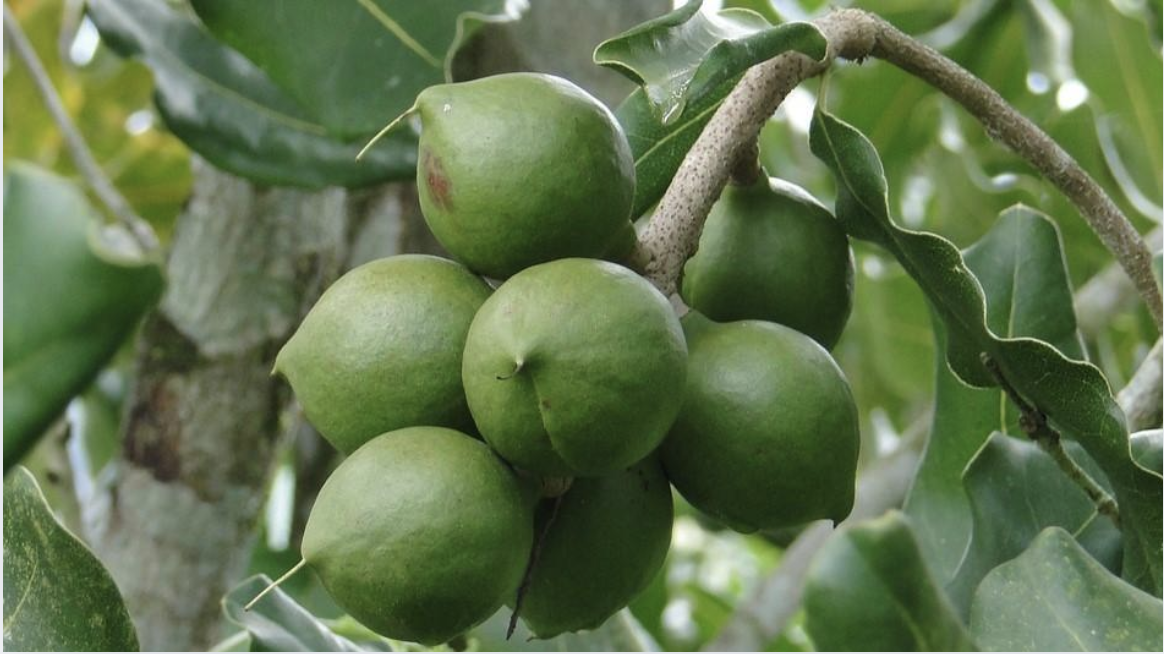
With a hard, woody shell and creamy white kernel inside, macadamia fruit is prized for its delicious, buttery nut.
The outer green husk splits open as the nut matures.
Macadamias are harvested for their edible nuts, which are enjoyed raw, roasted, in desserts, or as a topping for various dishes.
- Place of Origin: Australia
- Scientific Name: Macadamia integrifolia
- Famous Alternative Names: Queensland Nut, Bush Nut, Bauple Nut
Nutritional Content per 100 grams:
| Nutrient | Amount |
|---|---|
| Calories | 718 |
| Fat | 76 g |
| Carbohydrates | 14 g |
| Protein | 8 g |
| Fiber | 8.6 g |
Health Benefits:
- Rich in healthy monounsaturated fats, supporting heart health
- Contains antioxidants that protect cells from damage
- Good source of dietary fiber, aiding digestion
- Provides important minerals like magnesium and manganese which contribute to metabolic and bone health
39. Macoun Apple
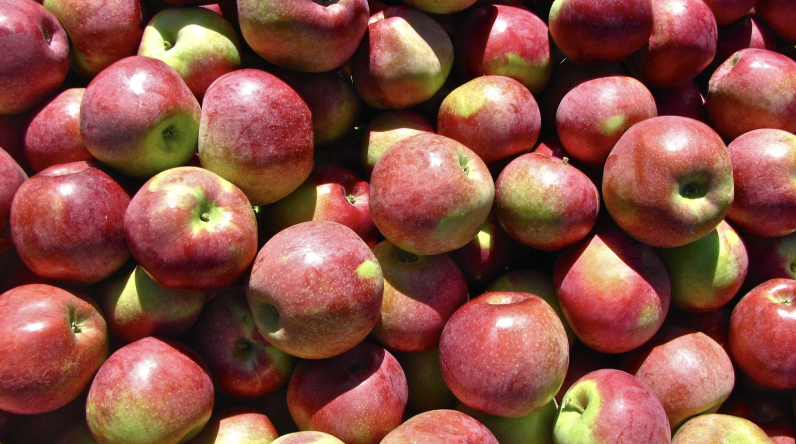
Macoun apple is a medium-sized, round fruit with deep red to purplish skin and a crisp, juicy white interior.
It is highly prized for its sweet, aromatic flavor and is often eaten fresh or used in salads, sauces, and desserts.
- Place of Origin: United States (New York)
- Scientific Name: Malus domestica ‘Macoun’
- Famous Alternative Names: None widely used
Nutritional Content per 100 grams:
| Nutrient | Amount |
|---|---|
| Calories | 718 |
| Fat | 76 g |
| Carbohydrates | 14 g |
| Protein | 8 g |
| Fiber | 8.6 g |
Health Benefits:
- High in dietary fiber, supporting healthy digestion
- Provides vitamin C for immune system health
- Contains antioxidants helpful for overall cellular protection
- Low in calories, making it suitable for healthy snacking
40. Maracuja

Golden-yellow to deep purple, this passion fruit variety offers a fragrant, sweet-tart pulp filled with edible seeds.
It is widely used in juices, desserts, and as a flavoring in culinary dishes throughout the tropics.
- Place of Origin: South America (Brazil, Paraguay, Argentina)
- Scientific Name: Passiflora edulis
- Famous Alternative Names: Passion Fruit, Granadilla, Parcha
Nutritional Content per 100 grams:
| Nutrient | Amount |
|---|---|
| Calories | 97 |
| Fat | 0.4 g |
| Carbohydrates | 23 g |
| Protein | 2.2 g |
| Fiber | 10.4 g |
Health Benefits:
- High in dietary fiber, supporting gut health
- Rich in vitamin C for immune support
- Contains plant compounds that may have calming effects
- Supplies beneficial antioxidants for overall wellness
41. Makok
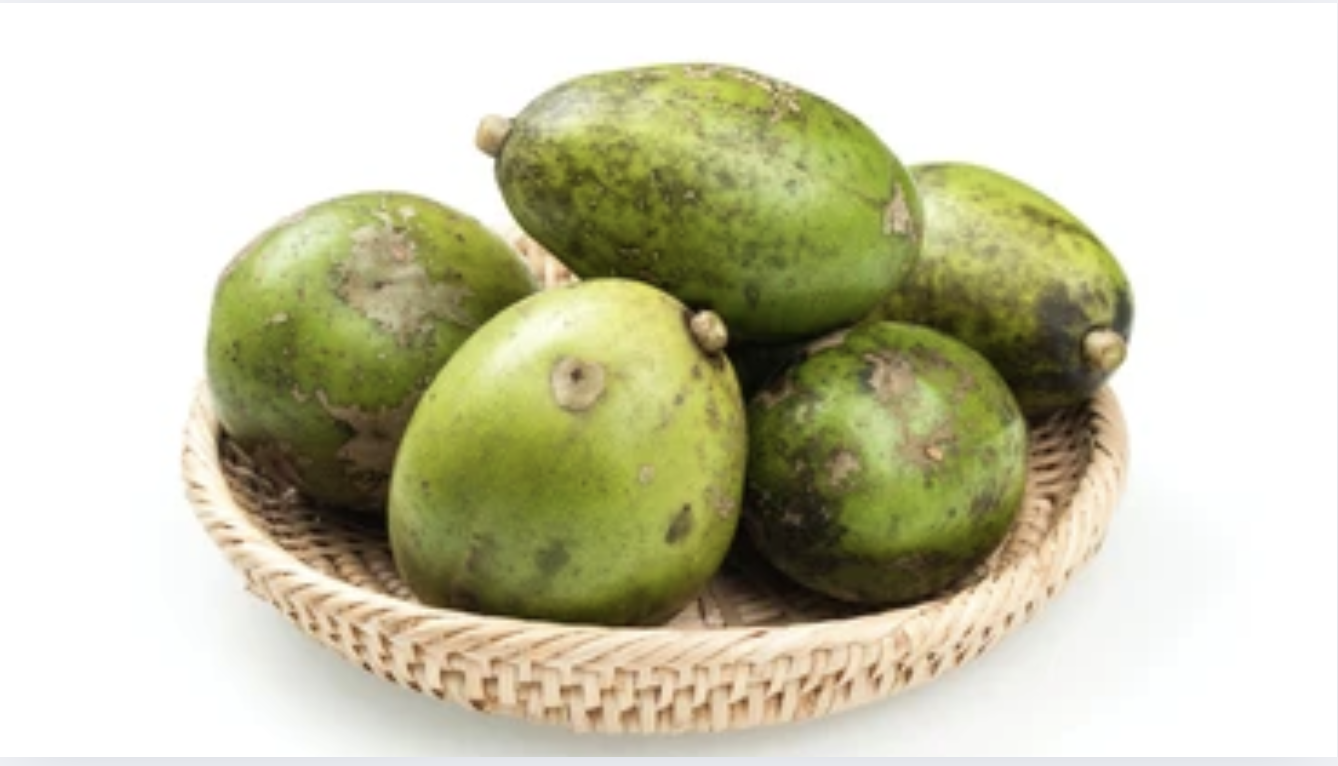
These small, green, oval fruits grow in clusters and have a crisp, sour-tart flavor.
Frequently eaten raw with salt or chili, Makok is used in salads and condiments in Southeast Asian cuisine.
- Place of Origin: Southeast Asia
- Scientific Name: Spondias pinnata
- Famous Alternative Names: Hog Plum, Ambarella (regional names vary)
Nutritional Content per 100 grams:
| Nutrient | Amount |
|---|---|
| Calories | 41 |
| Fat | 0.3 g |
| Carbohydrates | 10 g |
| Protein | 0.7 g |
| Fiber | 1.5 g |
Health Benefits:
- Supplies vitamin C to support immunity
- Contains dietary fiber for promoting digestion
- Offers antioxidants for cellular protection
- Traditionally used for its potential anti-inflammatory effects
More Fruits That Begin With The Letter M
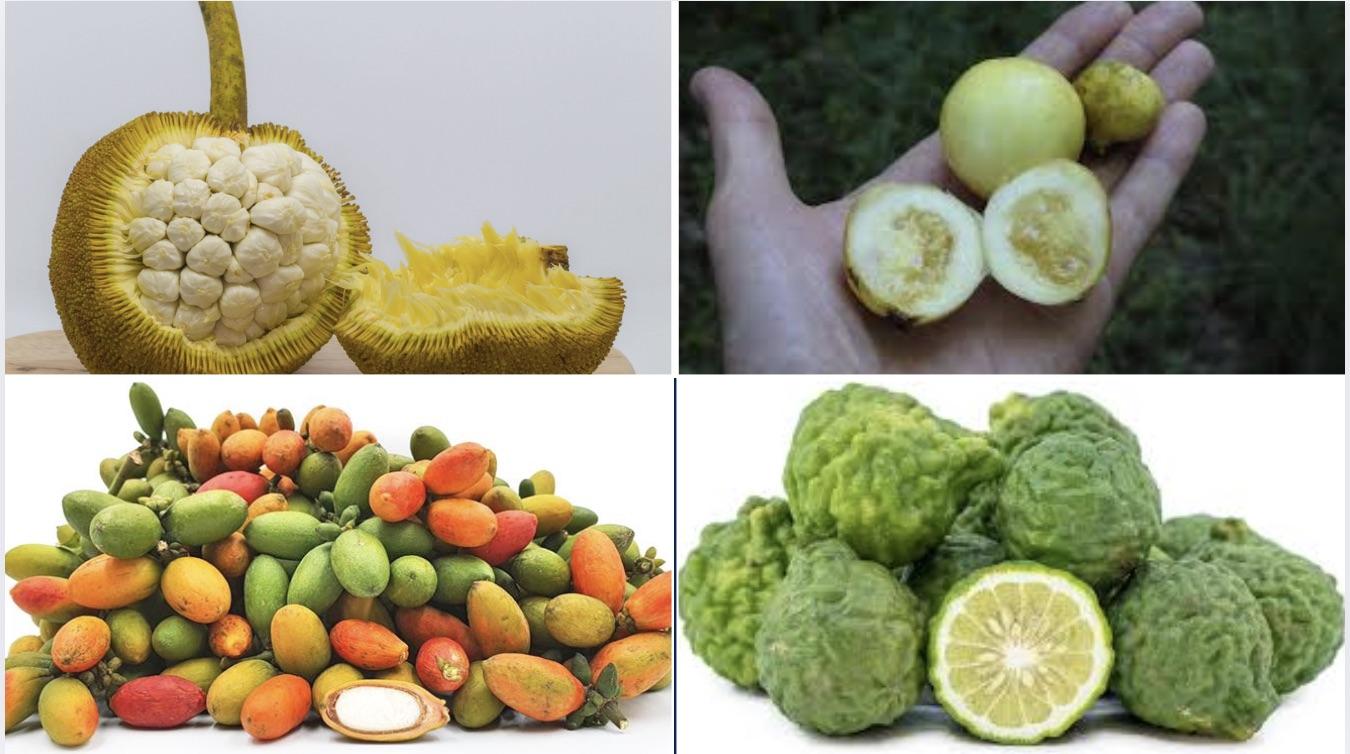
Here are some more fruits that begin with the magic letter “M”:
42. Marang
43. Marula Berry
44. Mayapple
45. Melinjo
46. Melothria
47. Mexican Hawthorn
48. Mexican Plumcot
49. Mimusops Scaber
50. Makrut Lime
51. Mountain Pepper Fruit
52. Muntingia
53. Muzzarella Fruit
54. Mamey Apple
55. Malaysian Grapes
56. Malgache Apple
57. Malunggay Fruit
58. Mammee Nut
59. Manila Tamarind
These marvelous “M” fruits show just how fun, flavorful, and diverse nature’s alphabet can be.
Conclusion
As we conclude our learning about the world of fruits that start with M, it’s clear that this world has much more to offer than just their initial letter.
From the sweet juiciness of mangoes to the tart tang of mulberries, M-fruits showcase an impressive range of flavors, textures, and nutritional benefits.
These fruits add variety to our diets and contribute significantly to our health and well-being.
Whether enjoyed fresh, in juices, or as part of culinary creations, fruits that start with M prove that nature’s alphabet is a huge treasure of delicious and nutritious options.
Incorporating these fruits into our diets enables us to find new flavors, support local and global agriculture, and improve our overall well-being.
Have you tried any fruit before?
Tell us in the comments below!!






